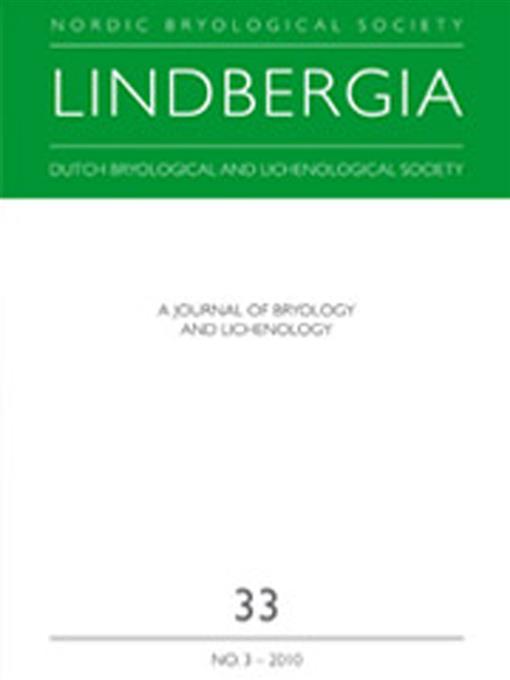The conditions at the first Swedish and mainland European Campylium longicuspis locality are described and compared with the few so far reported finds of this species. The species appears to prefer chiefly calcium-rich wetland habitats. Campylium longicuspis is mainly Arctic, and a map of its known distribution is presented.
The occurrence of predominantly Arctic or even high-Arctic moss species in the northern portion of the Scandinavian mountain range has for a long time been of great interest to Scandinavian bryologists (Mårtensson 1956). Examples of such species include Funaria arctica (Berggr.) Kindb. (Rumsey 1990), Psilopilum cavifolium (Wilson) I.Hagen (Long 1985, Lübenau and Lübenau 1971), Rhizomnium andrewsianum (Steere) T.J.Kop. (Engelmark 1974), and Timmia sibirica Lindb. & Arnell (Carlsson 2003). The occurrences of this kind of species add to the bryological temptations offered by the Scandes, but nowadays these species are also of great interest for another reason. The ongoing gradual climate change will most likely affect these species, which presumably depend on relatively cold conditions, relatively soon. It is therefore important both to find localities of such species, while the species still grow there, and to keep track of their future destiny.
During the summer of 2007 CJ carried out an investigation in the alpine region of the Swedish mountain range to improve our knowledge about the habitat “Pioneer formations of Caricion bicoloris-atrofuscae”, a habitat protected by the EU habitats directive (EEC 1992). In a small, 0.25 m2, field plot on Mt Pältsa in the northernmost portion of Sweden a few scattered, unbranched moss shoots were noticed. One shoot that was collected, and later identified by LH, turned out to belong to Campylium longicuspis (Lindb. & Arnell) Hedenäs (Hedenäs 1989). This species reminds a bit about C. laxifolium Engelmark & Hedenäs, but has longer (2.1–4.6 versus 1.8–2.4 mm) and more strongly concave stem leaves. The leaves are more narrowly ovate in their basal portion and have frequently got a short differentiated acumen, constituting 18–33% of the leaf length. During a second visit to the locality in 2011 by N. Lönnell and T. Hallingbäck the species was again found.
Globally, Campylium longicuspis was overlooked for a long time, but its distribution is now known to include large portions of the Arctic, with outliers in the Altai Mountains (Fig. 1). The present find is the first from the European mainland. In addition, C. longicuspis was reported from both Serbia and Montenegro (Sabovljevic et al. 2004). However, this is likely due to a mistake in interpreting the synonymy of C. longicuspis and C. protensum (Brid.) Kindb. (Martinčič 2009), and in addition it seems very unlikely that the Arctic C. longicuspis should occur in the Balkan area.
In the literature, C. longcuspis was reported both together with species of calcium-rich wetlands, such as Drepanocladus trifarius (F.Weber & D.Mohr) Paris, D. turgescens (T.Jensen) Broth., and Tomentypnum nitens (Hedw.) Loeske (Arnell, H. W. 1913, Arnell, S. and Mårtensson 1959, Lindberg and Arnell 1890) and in one case together with Blepharostoma trichophyllum (L.) Dumort., Scapania simmonsii Bryhn & Kaal., and Ceratodon (Arnell, H. W. 1913). Since the habitat of C. longicuspis is still rather poorly known (Hedenäs 2003), some observations from its newly found north Swedish site follow (Fig. 2). The site is located in a gentle slope, heading towards SW in a mountain pass. The vegetation is sparse with no trees or shrubs. The habitat of the species consists of very thin soil, most likely calcareous, often with trickling water or spring influence from the slopes nearby. Within the 0.25-m2 field plot with C. longicuspis, the following bryophytes were recorded: Aneura pinguis (L.) Dumort., Blepharostoma trichophyllum, Blindia acuta (Hedw.) Bruch & Schimp., Bryum sp., Campylium stellatum (Hedw.) C.E.O.Jensen, Cephalozia sp., Hylocomium splendens (Hedw.) Schimp., and Scorpidium cossonii (Schimp.) Hedenäs. In the same plot, 18 species of vascular plants were recorded, of which Bistorta vivipara (L.) Gray, Carex bicolor All., Saxifraga aizoides L., S. oppositifolia L., Saussurea alpina (L.) DC., Silene acaulis (L.) Jacq., and Thalictrum alpinum L. were most common. Of the other ones, Carex capillaris L., C. fuliginosa Schkuhr, Juncus biglumis L., Salix reticulata L., and Tofieldia pusilla (Michx.) Pers. can be mentioned.
Figure 1.
Distribution of Campylium longicuspis, with the N Scandinavian locality indicated with a dot having a double line. The map is based on material present in S, and the literature (Afonina 2004, Czernyadjeva 2001, Fedosov, et al. 2011, Hedenäs 1989, 2003, Ignatov 1994, Ignatov, et al. 2006). The Canadian record (‘?’) is based on information in (Afonina 2004) where this was published as from ‘Arctic Canada’, but with no more exact locality information.

Cited specimen: Sweden: Torne Lappmark, Karesuando, Mt Pältsa, plot 1 (WP 669), 69°00′28.7″N, 20°23′68.6″E (WGS-84), 1090 m a.s.l., thin soil with trickling water, most likely calcareous and sometimes with spring influence, leg. C. Jacobson, 10 August 2007, det. L. Hedenäs (S; reg. No. B183239).






